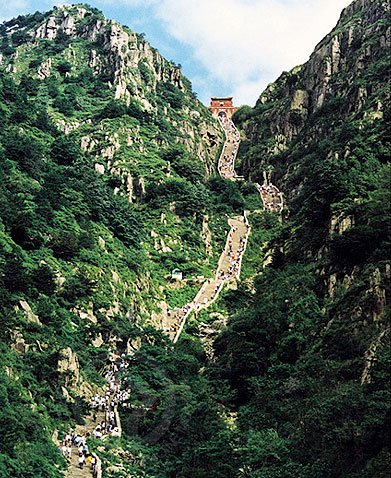Taishan Mountain
 Taishan Mountain lies in central Shandong Province, spanning the ranges of Tai′an and Jinan cities. It covers an area of 550 square meters. It was regarded as preeminent among China′s Five Sacred Mountains. 72 Chinese emperors of various dynasties made pilgrimages to Taishan Mountain for sacrificial and other ceremonial purposes, including Emperor Shihuang of the Qin Dynasty (221-206BC), Emperor Wudi of the Han Dynasty (206BC-8AD), Emperor Xuanzong of the Tang Dynasty (618-907) and Emperor Qianlong of the Qing Dynasty (1644-1911).
Taishan Mountain lies in central Shandong Province, spanning the ranges of Tai′an and Jinan cities. It covers an area of 550 square meters. It was regarded as preeminent among China′s Five Sacred Mountains. 72 Chinese emperors of various dynasties made pilgrimages to Taishan Mountain for sacrificial and other ceremonial purposes, including Emperor Shihuang of the Qin Dynasty (221-206BC), Emperor Wudi of the Han Dynasty (206BC-8AD), Emperor Xuanzong of the Tang Dynasty (618-907) and Emperor Qianlong of the Qing Dynasty (1644-1911).
Taishan Mountain is endowed with many scenic spots. A large number of them were given names in ancient times. They include 112 peaks, 98 precipices, 18 caves, 58 oddly shaped rocks, 102 streams and valleys, 56 pools and waterfalls, and 64 springs. Vegetation covers 79.9% of the area. The flora is known to comprise 989 species in 144 families.
Taishan Mountain also boasts cultural heritage with an incessant history of several thousand years. Currently on the mountain, there are 22 ancient architectural complexes, 97 ruins, 819 stone tablets and 1,800 stone inscriptions, which provide a natural museum for the study of ancient history and calligraphy. Main sites of interest are the Tiankuang Temple, Nantian Gate, Azure Cloud Temple, Peak for Viewing the Sun, and Sutra Rock Valley, etc.
Taishan Mountain is a mountain of outstanding value from the pointview of aesthetics, science, history and culture. Taishan Mountain was elected to the "World Heritage List" in 1987. Chinese people tend to describe a situation as being as stable as Taishan Mountain or a matter as being as weighty as Taishan Mountain, giving clear evidence of such an impression.
Source: http://www.chinaculture.org